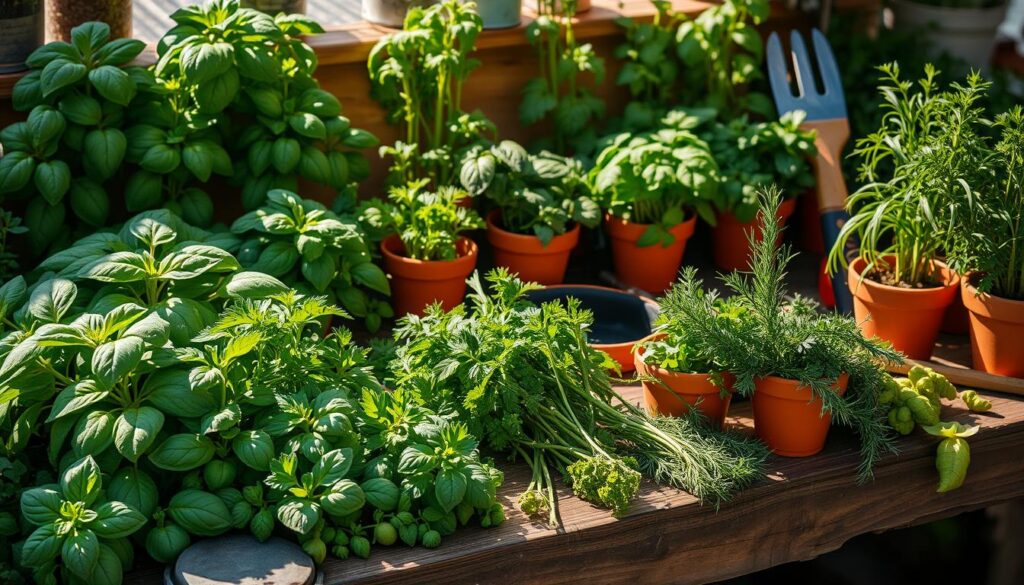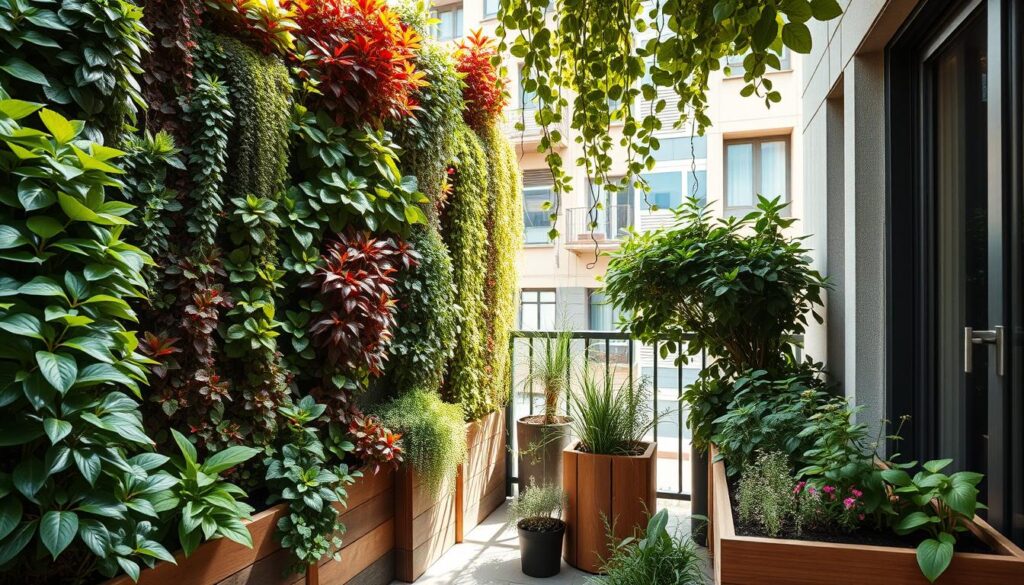How to Attract Bees and Pollinators with Flowers in Your Backyard
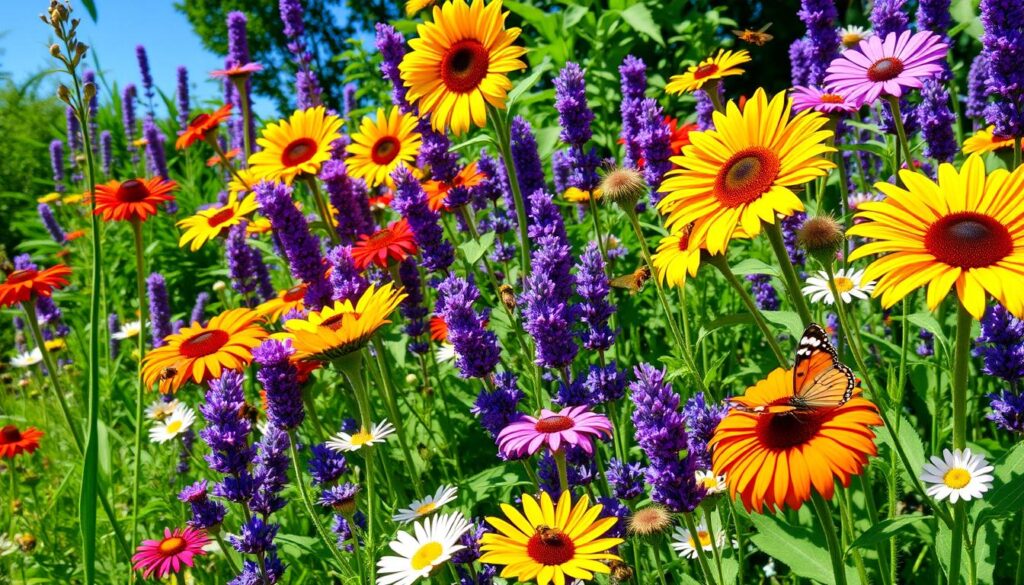
Creating a pollinator garden is a great way to help bees and support nature. By planting flowers that bees love, you can make a big difference.
A pollinator garden is a beautiful place for bees and other pollinators to find what they need.
Attracting bees and pollinators is rewarding. It starts with picking the right flowers. Choose plants that are full of nectar and pollen to welcome these important insects.
A bee-friendly garden is good for the environment and adds beauty to your backyard.
Understanding the Importance of Bees and Pollinators
Bees and pollinators are key to a healthy ecosystem balance. They help many plants reproduce. Without them, our food supply would suffer, making bee conservation crucial.
These creatures do more than just help with food. They also keep ecosystems diverse, supporting a wide range of wildlife.
The Role of Bees in Ecosystems
Bees are vital pollinators, crucial for many crops like fruits, veggies, and nuts. Losing them could upset ecosystem balance significantly.
How Pollinators Affect Food Production
Pollinators, including bees, are key for food. They help crops reproduce and set seed. Without them, many crops would fail to produce, leading to less food.
Threats Facing Bee Populations
Bee populations face many dangers, like habitat loss, pesticides, and climate change. These threats harm bee conservation efforts. We need sustainable practices to protect these vital pollinators.
- Habitat loss and fragmentation
- Pesticide use and pollution
- Climate change and extreme weather events
Understanding bees and pollinators’ importance helps us protect them. We can support bee conservation and promote sustainable practices. This ensures a healthy ecosystem balance and highlights pollinator importance.
Choosing the Right Flowers for Bees
Creating a bee-friendly garden starts with picking the right flowers. Native flowers like coneflowers and black-eyed susans are perfect. They attract bees and other pollinators because they’ve evolved together.
Bee-friendly plants like lavender and mint are also good choices. They’re full of nectar and have a scent bees adore. Mixing native flowers and bee-friendly plants makes your garden a welcoming place for pollinators.
Seasonal gardening is key to attracting bees. Planting flowers that bloom at different times ensures a steady supply of nectar and pollen. This not only helps bees but also makes your garden more beautiful and varied.
Native Plants That Attract Bees
- Coneflowers
- Black-eyed susans
- Butterfly weed
Sweet-Smelling Flowers That Lure Pollinators
Flowers with a strong scent, like roses and freesia, also attract bees. Their fragrance is detectable from far away, making them a wonderful addition to any garden.
Seasonal Flowering Plants
For summer, sunflowers and zinnias are great for bees. Planting a variety of seasonal flowers creates a lively and inviting space for pollinators all year.
Creating a Bee-Friendly Garden Design
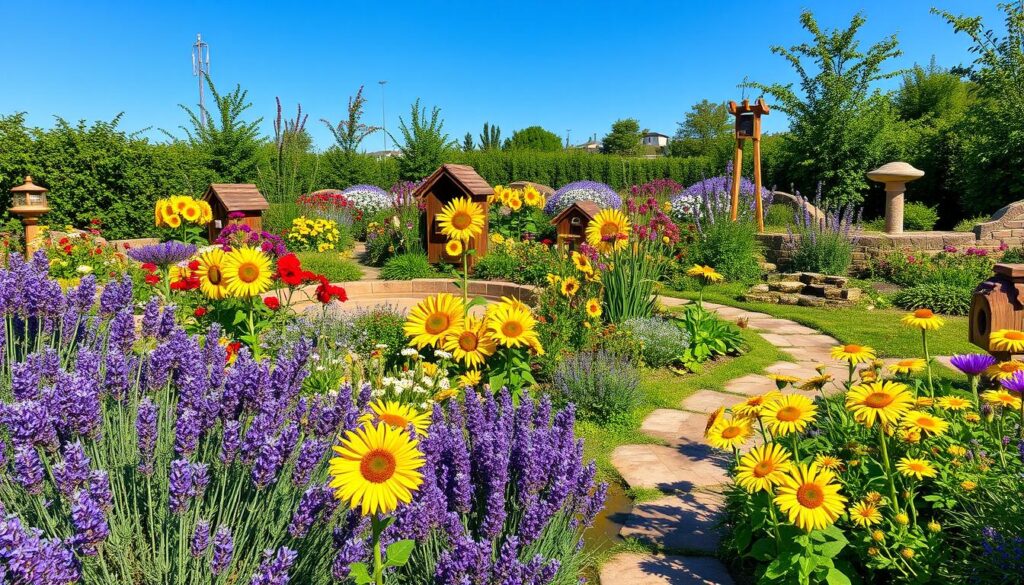
A well-planned garden can attract many bees and pollinators. When designing, choose flowers that offer nectar and pollen. A mix of native plants, sweet flowers, and seasonal blooms welcomes pollinators.
Grouping flowers helps bees move easily. Plant them in clusters. Adding water sources, like shallow dishes or birdbaths, also supports pollinators.
- Planting a mix of flowers that bloom at different times to provide a constant source of nectar and pollen
- Incorporating native plants that are naturally attractive to local pollinators
- Providing a source of water, such as a shallow dish or birdbath, for bees to drink from
- Creating a garden layout that allows for easy access to flowers and water sources
By adding these elements, you can make a garden that helps pollinators. It becomes a welcoming place for these important insects.
| Flower Type | Bloom Time | Attracts |
|---|---|---|
| Native Wildflowers | Spring-Fall | Bees, Butterflies |
| Sunflowers | Summer | Bees, Birds |
| Lavender | Summer | Bees, Butterflies |
Best Flower Types to Attract Different Bees
Planting the right flowers in your backyard can really help attract bees. Different bees like different flowers. By mixing perennial and annual flowers, you can make your garden a welcoming place for many pollinators.
Perennial flowers like coneflowers and black-eyed susans are perfect for bees. They come back every year, offering a steady supply of nectar and pollen. Annuals like sunflowers and zinnias also attract bees and add vibrant colors to your garden.
Perennial Flowers That Keep Coming Back
- Coneflowers
- Black-eyed susans
- Bee balm
Annuals That Are Bee Favorites
- Sunflowers
- Zinnias
- Cosmos
Wildflowers are also great for your garden. They’re easy to grow and attract many pollinators. By choosing a variety of flowers, you can make your garden a haven for bees.
| Flower Type | Attraction Level |
|---|---|
| Perennial Flowers | High |
| Annuals for Bees | Medium |
| Wildflowers | High |
How to Maintain a Bee-Friendly Garden
To keep a bee-friendly garden, you need to pay close attention and use natural methods. Watering and caring for your plants is key. Make sure they get the right amount of water and nutrients.
It’s also important to avoid harmful chemicals and pesticides. These can hurt bees and other pollinators. Instead, use natural ways to fight pests and diseases. This could be introducing beneficial insects or using physical barriers.
Seasonal Gardening Tips
To make your garden a success, follow seasonal tips. Plant a mix of flowers that bloom at different times. This ensures bees always have nectar and pollen. Here are some examples:
- Spring-blooming flowers like crocuses and daffodils
- Summer-blooming flowers like sunflowers and zinnias
- Fall-blooming flowers like asters and sedum
The Benefits of Diverse Flowering Plants
Having a garden with many types of flowers is key to attracting bees. Different flowers offer nectar and pollen, which bees need to survive. Diverse flowering plants also make a welcoming space. They bloom at various times, ensuring bees always have food.
The color variety of flowers is vital for bee attraction. Bees love flowers with bright colors, especially those that reflect ultraviolet light. By adding colorful flowers, you can make your garden a haven for bees.
Why Diversity Matters for Attracting Bees
A variety of flowers offers many benefits for bees. They provide:
- A constant source of nectar and pollen
- Different shapes and sizes for various bee species
- A long blooming period for ongoing food supply
How Color Variety Affects Bee Attraction
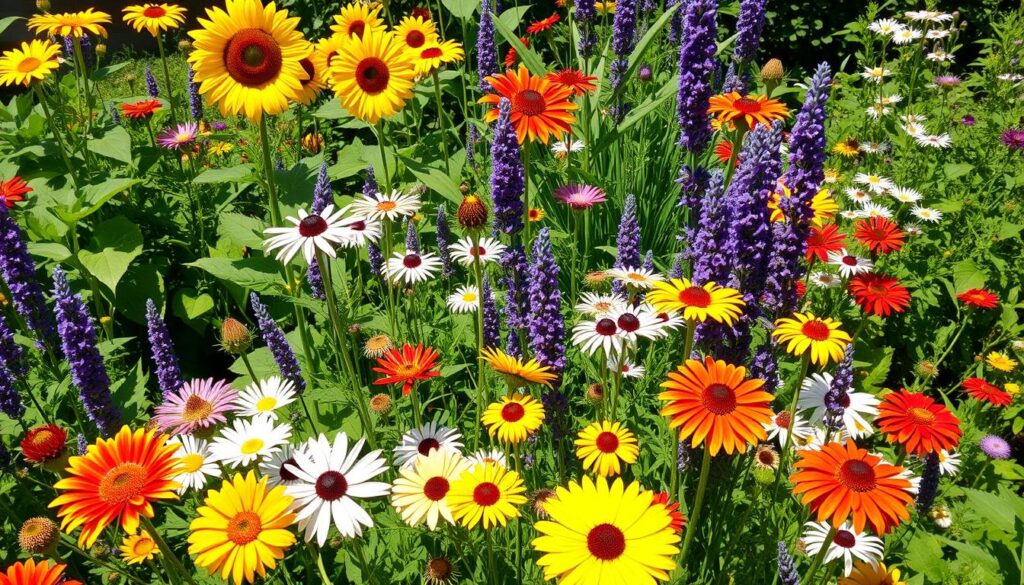
Bees are drawn to flowers with bright colors, especially ultraviolet ones. Some colorful flowers that attract bees include:
- Sunflowers
- Zinnias
- Cosmos
Minimizing Competition Among Flowers
To avoid flower competition, plant a mix of flowers that bloom at different times. This lets each flower attract bees without rivalry.
By adding diverse flowering plants to your garden, you create a welcoming space for bees. This not only beautifies your garden but also helps the environment. With some planning, you can make your garden a haven for bees and a treasure for the environment.
Engaging the Community for Bee Awareness
Community engagement is key for bee awareness and pollinator protection. Working together, we can greatly help bees and other pollinators.
One way to get the community involved is by hosting workshops on pollinator gardening. These workshops teach how to create gardens that help bees. Local gardening clubs can help spread the word and encourage more people to join in.
Hosting Workshops on Pollinator Gardening
Workshops on pollinator gardening are a great way to teach people about bees. They cover important topics like:
- How to create a bee-friendly garden
- Which plants attract pollinators
- How to keep a garden healthy and sustainable
Collaborating with Local Gardening Clubs
Working with local gardening clubs can boost bee awareness. These clubs offer a place for people to share knowledge and plan events for pollinator protection.
Supporting Pollinator Protection Initiatives
Supporting pollinator protection is crucial for bee conservation. Ways to help include:
| Initiative | Description |
|---|---|
| Pollinator-friendly gardening | Creating gardens that provide a habitat for pollinators |
| Bee conservation programs | Supporting programs that protect and conserve bee populations |
| Community education | Providing education and outreach to the community about the importance of pollinator protection |
By engaging the community and promoting bee awareness, we can protect these vital pollinators. This ensures the health of our ecosystem.
Observing Bees in Your Garden
Creating a bee-friendly garden is more than just planting flowers. It’s about watching and learning from these pollinators.
By observing bees, you can understand their behavior and support them better. This hands-on learning is perfect for gardening with education in mind.
Timing is key when watching bees. They are most active on warm, sunny days when flowers bloom.
This is when you can see them gathering nectar and pollen. By noticing which flowers attract different bees, you can make your garden even more welcoming.
Best Practices for Observing Bees
- Choose a quiet, comfortable spot to observe bees, away from distractions
- Use binoculars to get a closer look without disturbing the bees
- Keep a journal to record your observations and note any interesting behaviors
- Learn about bee identification to recognize different species and their unique characteristics
By following these tips and gardening for education, you can enjoy watching bees more. Always be patient and respectful, and remember to keep their safety in mind.
Encouraging Sustainability in Your Garden
Creating a bee-friendly garden is more than just attracting pollinators. It’s about adopting sustainable practices for your garden’s long-term health. Composting is a key step in promoting sustainability.
Composting and Its Benefits for Pollinators
Composting your garden waste reduces landfill waste and creates nutrient-rich soil. This soil nourishes your plants and supports bees and other pollinators. It also makes your garden healthier and more vibrant.
Sustainable Practices for Long-Term Benefits
There’s more to sustainable gardening than composting. Try water-efficient irrigation, avoid harmful pesticides, and use native plants. These actions help pollinators and save natural resources, reducing your environmental impact.
Educating Others About Bee Conservation
Share your knowledge and inspire others to create bee-friendly gardens. Join community events, work with local gardening clubs, or host workshops. Together, we can make a difference for our gardens and the creatures that live there.
Recommended content: How to Start a Home Garden
